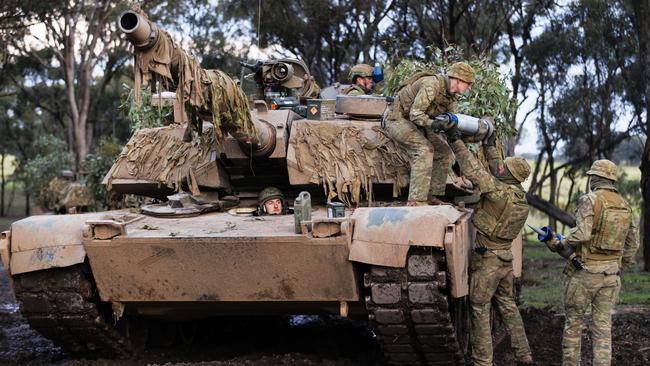
Pete Hegseth, the tough-talking US Secretary of Defence, has “conveyed” to Richard Marles “that Australia should increase its defence spending to 3.5 per cent of its GDP as soon as possible”.
A “readout” of this meeting was released by the US Department of Defence. Marles’ evasive comment was only “that’s a conversation we are totally up for in terms of the way in which we engage with the United States”.
Australian governments over the past decade should be condemned for failing to take our own security seriously.
Scott Morrison announced AUKUS in September 2021 but never provided additional funding to make it happen. Since Anthony Albanese was elected in May 2022 Labor has barely lifted funding from the long-term projection set a decade ago in the Defence white paper Malcolm Turnbull released in February 2016.
The only defence spending increase Labor agreed was an extra $50.3bn to be spent over a decade to 2033-34. That sounds like (and indeed is) a lot of money but almost all of it will be spent after the 2028 election.
Future spending promises aren’t worth the paper they are written on, any more than a spending commitment made by Tony Abbott or Malcolm Turnbull in 2015 impacts on what the Albanese government does today.

Marles says his government has made “the largest peacetime increase in defence spending since the end of the Second World War”.
The claim is pure sophistry. In dollar terms every area of government spending is larger in 2025 than it was in 2024 and will be larger again in 2026.
The truth is that we are spending just over 2 per cent of GDP on defence. For most of our post-war history defence spending has been higher than that. In the Cold War, spending was closer to 3.5 per cent of GDP. Now the government, with Marles in the lead, claims that our current era is more dangerous than it was during the Cold War.
Marles’ failure to persuade his colleagues to lift defence spending means the current Australian Defence Force is being hollowed out to pay for AUKUS submarines.
Look at the dilapidated state of a large part of our navy’s surface fleet currently at Fleet Base East in Sydney Harbour. We have a navy no longer able to put to sea in anything but token numbers.
Not all parts of the ADF are in this state: our defence people are fantastic and there is some excellent equipment in service, such as the Joint Strike Fighters, but the ADF is in crisis, which is why people are leaving the services in big numbers.
This crisis is made vastly worse by the Albanese government through a combination of uninterest, incompetence and the delusional belief that Albanese has “fixed” relations with China.

It is surprising that the Americans have taken so long to raise these concerns publicly, but as I have been writing in these pages for a long time, we have a major alliance problem on our hands if we don’t heed Hegseth’s call to do more for our own defence.
Already, though, Albanese has rejected Hegseth. He said on Monday: “Investing in our capability and investing in our relationships. That’s what we’re doing. That’s what we’ll continue to do.”
Albanese risks being given a lesson in great power politics. He has failed to invest in the US relationship which, by the length of the home straight, is the most important strategic relationship we have. If that’s Albanese’s attitude he shouldn’t go to the G7 meeting in Canada and avoid personal contact with Donald Trump.
Perhaps that’s the PM’s strategy: making himself Oceania’s Justin Trudeau – pushing back at Trump and keeping defence weak while padding social spending.
A 3.5 per cent defence budget would add $42bn to the current $56bn spend. Realistically, it would take five years to step the budget up to that level.
If the money was available, what should we do with it? The Defence Department and ADF would need deep reform to change thinking and acquisition plans. The need is to become faster, more creative and innovative and to learn some of the lessons being demonstrated in wars in Ukraine and the Middle East.
Here’s how I would prioritise the additional spending:
First, the ADF needs to be made combat ready and able to sustain military operations for lengthy periods. A great deal of hollowness and hidden weakness needs to be fixed.
Second, we should look to expand the military by about 25,000 personnel or more. That means fixing recruitment. This job needs personal attention from the PM, signalling to the ADF that it is a government priority.
Third, I would boost reserves and cadets. People, not equipment, are the most pressing need.
Fourth, we urgently need more long-range strike capability and masses of armed drones for air, sea, undersea and ground operations. Some of this is happening, but too slowly.
Fifth, we need deep investment in air and missile defence to protect bases, infrastructure, even some population centres. How would ADF bases stand up to a drone attack like Ukraine so successfully launched against Russia? The answer is: very poorly.
Sixth, we need to turbocharge domestic industry for our, and allied, needs. Seventh, we must speed up the wider AUKUS technology agenda, moving away from a handful of never-ending science projects to something that looks like a DARPA or Skunkworks weapons development laboratory.
Point eight: the Collins submarines are too old to realistically have their service life extended. I would reopen a conversation with Japan for a number of smaller conventional submarines to act as a stopgap between the Collins and AUKUS subs.
Spending 3.5 per cent of GDP on defence sounds like a lot only because we have been underinvesting for decades. It would take us back to Cold War levels of spending. It’s what we should be spending to look after our own interests, not because Hegseth has asked for it.






